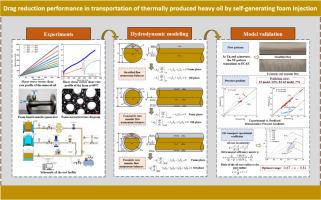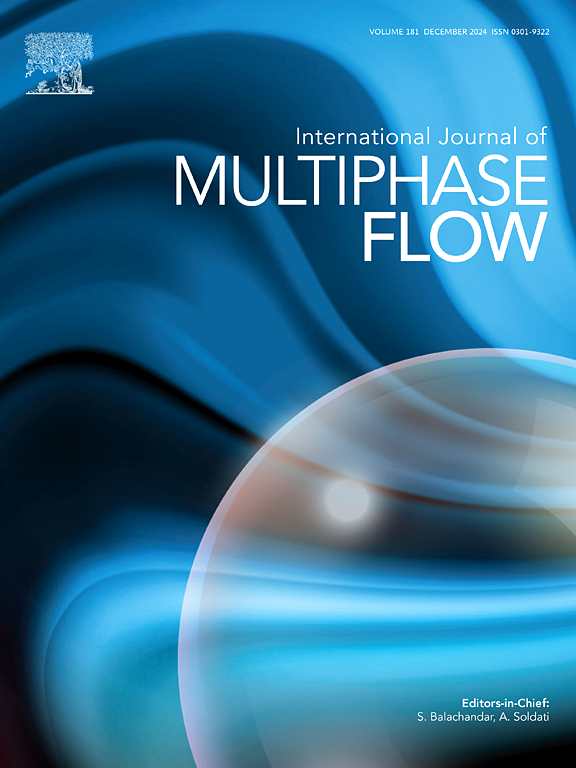Drag reduction performance in transportation of thermally produced heavy oil by self-generating foam injection
IF 3.8
2区 工程技术
Q1 MECHANICS
International Journal of Multiphase Flow
Pub Date : 2025-08-06
DOI:10.1016/j.ijmultiphaseflow.2025.105389
引用次数: 0
Abstract
This work proposes a novel approach utilizing an oil-resistant, thermally stable self-generating foam system to achieve boundary lubrication drag reduction in thermal heavy oil transportation, focusing on the drag reduction characteristics of non-Newtonian self-generating foam and Newtonian oil phases under horizontal pipe co-flow conditions. Experiments were conducted in a 12-m-long, 25-mm-inner-diameter horizontal borosilicate glass pipe with roughened walls, measuring pressure gradients for co-flowing high-viscosity oil and foam at superficial velocities of 0.12–0.65 m/s (oil) and 0.06–0.63 m/s (foam). High-speed imaging identified stratified flow (ST) and eccentric core annular flow (ECAF) as dominant regimes across tested conditions. A three-zone two-phase model was developed for horizontal foam-oil flows, integrating the Carreau-Yasuda rheology of self-generated foam at 60°C. The model demonstrates strong agreement with experimental data over broad operational ranges, confirming that full oil core encapsulation by foam determines the critical foam injection volume fraction for maximum drag reduction. Additionally, optimal oil transport efficiency was linked to specific oil core-to-pipe diameter ratios.

热采稠油输运自生泡沫减阻性能研究
本文提出了一种利用耐油、热稳定的自生泡沫系统实现热稠油输送边界润滑减阻的新方法,重点研究了水平管道共流条件下非牛顿自生泡沫和牛顿油相的减阻特性。实验在长12 m、内径25 mm、壁粗化的水平硼硅玻璃管内进行,测量了高粘度油和泡沫在表面速度0.12-0.65 m/s(油)和0.06-0.63 m/s(泡沫)下共流的压力梯度。高速成像识别出分层流动(ST)和偏心岩心环空流动(ECAF)是测试条件下的主要流动形式。在60°C条件下,结合自生泡沫的carau - yasuda流变学,建立了水平泡沫-油流动的三区两相模型。该模型与广泛操作范围内的实验数据非常吻合,证实了泡沫全油岩心封装决定了最大减阻的临界泡沫注入体积分数。此外,最佳输油效率与特定的岩心与管径比有关。
本文章由计算机程序翻译,如有差异,请以英文原文为准。
求助全文
约1分钟内获得全文
求助全文
来源期刊
CiteScore
7.30
自引率
10.50%
发文量
244
审稿时长
4 months
期刊介绍:
The International Journal of Multiphase Flow publishes analytical, numerical and experimental articles of lasting interest. The scope of the journal includes all aspects of mass, momentum and energy exchange phenomena among different phases such as occur in disperse flows, gas–liquid and liquid–liquid flows, flows in porous media, boiling, granular flows and others.
The journal publishes full papers, brief communications and conference announcements.

 求助内容:
求助内容: 应助结果提醒方式:
应助结果提醒方式:


